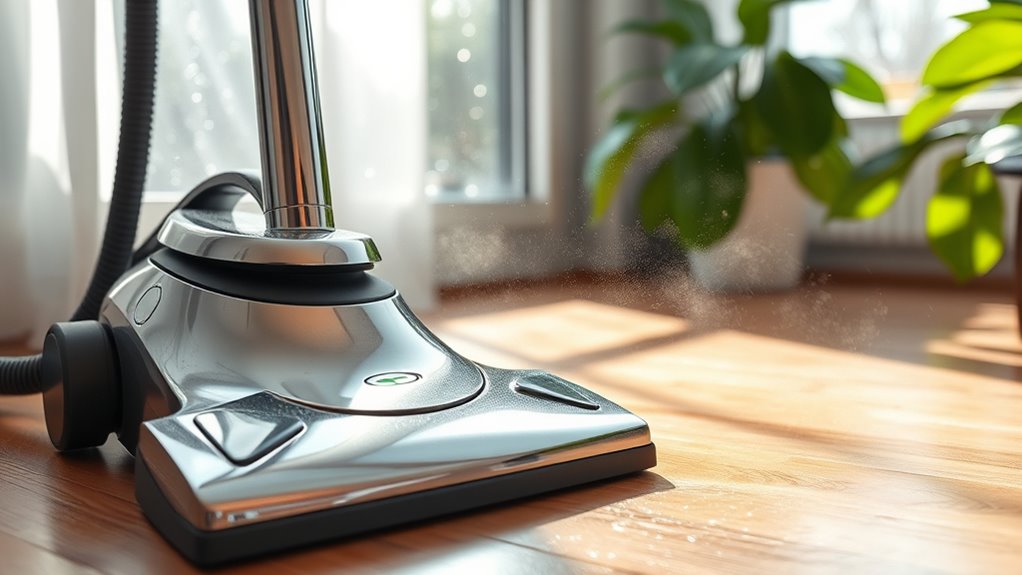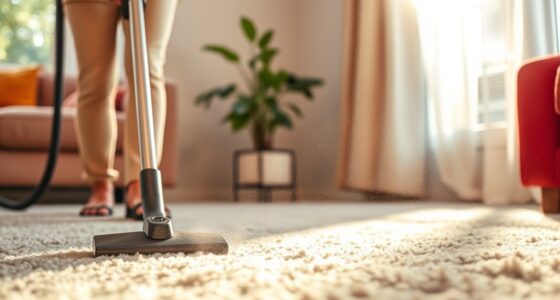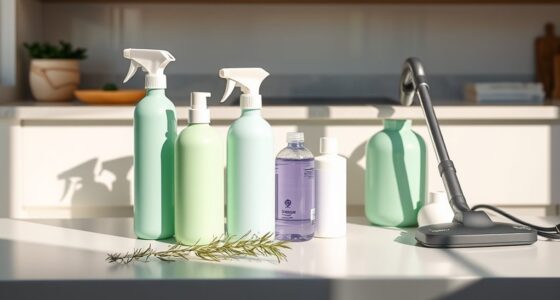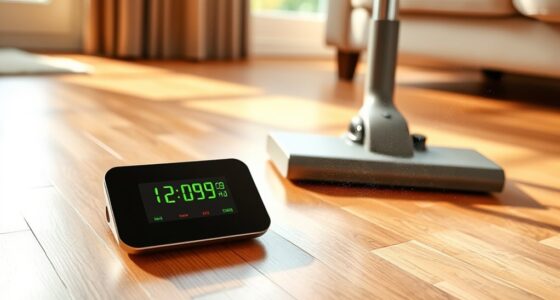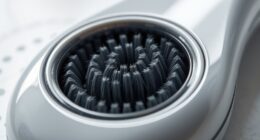High humidity increases airborne allergens like mold spores and dust mites, which can trigger allergy symptoms and respiratory discomfort. In these damp conditions, vacuum cleaners struggle to effectively capture allergens, as moisture diminishes their performance and filtration efficiency. By controlling humidity levels between 30-50%, you can reduce allergen proliferation and improve your vacuum’s effectiveness. Managing humidity not only creates a healthier living space but also minimizes allergy flare-ups. Discover more about effective humidity control strategies below.
Key Takeaways
- High humidity levels promote mold growth and dust mite proliferation, increasing airborne allergens in indoor environments.
- Elevated moisture leads to more frequent allergy flare-ups and respiratory discomfort due to increased allergen presence.
- Vacuum cleaners struggle to effectively capture allergens in high humidity, reducing their overall performance and efficiency.
- Maintaining humidity between 30-50% helps minimize mold and dust mites, improving indoor air quality and reducing allergy symptoms.
- Using dehumidifiers and monitoring humidity levels enhances vacuum efficacy and creates a cleaner, healthier living space.
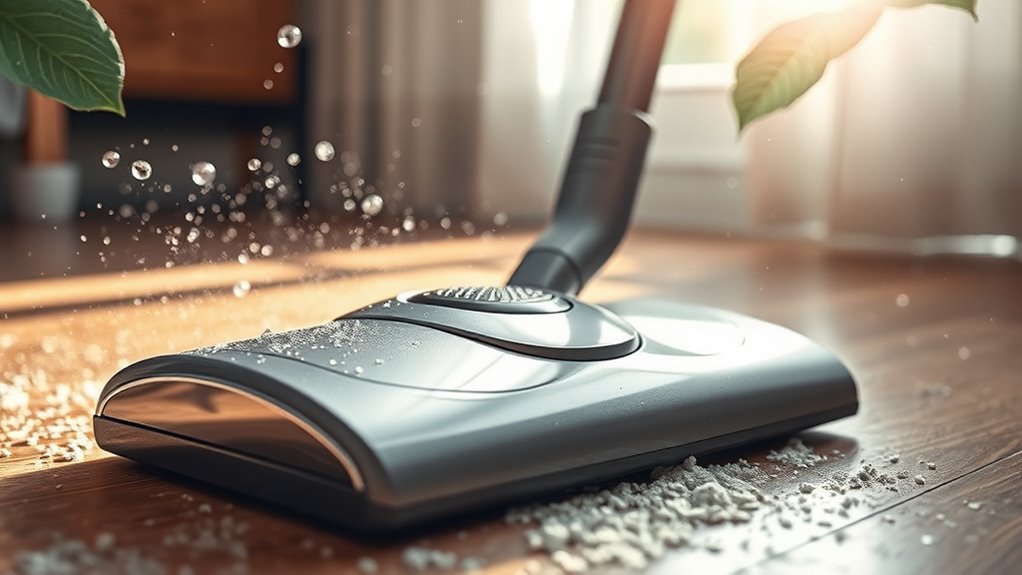
While you might not realize it, humidity plays a crucial role in both the prevalence of allergens in your home and the effectiveness of your vacuum cleaner. When humidity levels rise, you may find that your allergies act up more frequently. This is largely due to the fact that airborne mold thrives in damp environments. If your home has high humidity, mold spores can easily float through the air, triggering allergic reactions. You may notice this when you breathe in and experience sneezing or coughing, making your living space uncomfortable.
Humidity significantly impacts allergens in your home, often worsening allergy symptoms and limiting your vacuum cleaner’s effectiveness.
Dust mites also love humidity. In fact, dust mite proliferation is directly linked to moisture levels in your home. These tiny pests thrive in warm, humid conditions, and they can easily multiply in your bedding, carpets, and upholstery. When humidity is high, you may find that your vacuum cleaner struggles to pick up these allergens. It’s not just about dirt and debris; your vacuum has to tackle microscopic invaders like dust mites and mold spores as well. If the humidity is too high, your vacuum cleaner’s performance can diminish, leaving allergens behind that could aggravate your allergies.
To combat this, consider using a dehumidifier. By lowering humidity levels, you can create an environment that discourages both airborne mold and dust mites. This not only helps reduce the number of allergens in your home but also enhances your vacuum cleaner’s ability to pick up dust and debris. A well-maintained vacuum with a good filtration system will do a better job when humidity is controlled, ensuring that it captures a higher percentage of allergens, including those pesky dust mites and mold spores.
Regularly checking humidity levels can make a significant difference. Aim for a relative humidity of around 30-50%. If you find that your home often exceeds this range, taking steps to regulate it can lead to a healthier indoor environment. You’ll likely notice fewer allergy flare-ups and a cleaner living space. Moreover, maintaining optimal humidity levels can also improve your vacuum cleaner’s overall performance by allowing it to effectively capture more allergens.
Frequently Asked Questions
How Does Humidity Affect Indoor Air Quality Overall?
Humidity profoundly affects indoor air quality. When humidity levels rise, you’re likely to see increased mold growth and dust mite proliferation. These allergens can worsen respiratory issues and trigger allergies. Keeping humidity levels in check helps maintain a healthier environment by minimizing these risks. Regularly using dehumidifiers and ensuring proper ventilation can make a big difference. By doing this, you’ll create a more comfortable and healthier living space for yourself and your family.
Can Vacuuming Too Often Worsen Allergen Problems?
Vacuuming too often can actually stir up allergen buildup, sending dust and dander swirling back into the air like a hidden storm. You might think you’re keeping your space clean, but if your vacuum maintenance isn’t up to par, it can release more allergens than it captures. Instead, balance your vacuuming routine with thorough checks on your vacuum’s filters and bags to guarantee you’re truly reducing allergens rather than exacerbating the problem.
What Types of Vacuums Are Best for High Humidity Areas?
If you’re in a high humidity area, moisture resistant vacuums with effective vacuum filtration are your best bet. These vacuums prevent mold and mildew growth while maintaining suction power. Look for models with HEPA filters, as they trap allergens efficiently. Additionally, consider bagless options that can handle moisture without damaging the motor. By choosing the right vacuum, you’ll keep your home clean and reduce allergen issues effectively.
Are There Specific Allergens That Thrive in Humid Conditions?
Absolutely, humid conditions create a breeding ground for specific allergens. Mold growth flourishes in damp environments, spreading spores that can trigger allergies. Similarly, dust mite proliferation skyrockets with increased humidity, as these tiny pests thrive in moist air. You might not see them, but they’re lurking in your bedding and carpets. Keeping your space dry is essential to combat these unwelcome guests and reduce allergy symptoms.
How Can I Reduce Humidity Levels in My Home Effectively?
To effectively reduce humidity levels in your home, consider investing in a dehumidifier. These devices can considerably lower moisture in the air. Additionally, improve air circulation by opening windows or using fans to promote airflow. Make certain ventilation in areas like kitchens and bathrooms to prevent excess moisture buildup. Regularly check for leaks and seal any gaps to prevent humid air from entering your home. Combining these methods will help you maintain a comfortable environment.
Conclusion
So, the next time you reach for that vacuum, consider the humidity lurking in your home. It might just be the secret culprit behind your allergy struggles and vacuum’s lackluster performance. What if I told you that adjusting your environment could uncover a cleaner, healthier space? Don’t underestimate the power of humidity—your allergies and vacuum could be in for a surprise! Are you ready to take control and breathe easier? The choice is yours.
